I have started this post and deleted it a couple times. Either it was too wordy or too technical. This is an attempt to breakdown the ramifications of changing the zoning along Fayette Street between 8th Avenue and the Whitemarsh border just past 11th Avenue.
This area is currently zoned Residential/Office. What does that mean? I looked it up on the Borough’s website (click to see the full zoning code) and found that this zoning classification was created for the following reason:
In the expansion of the declaration of legislative intent contained in Part 1, the intent of the Residential Office District is to encourage the retention and preservation of existing Victorian and early 20th Century residences by permitting residential uses and conditionally allowing limited office conversions. Furthermore, it is the intent of this Part to maintain the existing residential streetscape of upper Fayette Street through regulations that allow these conversions only when front facades and porches are preserved and if building additions and parking areas are not constructed in the front yards.
The zoning code than details what is permitted and permitted conditionally in a Residential/Office Zoning District:
§ 27-1202. Permitted Uses.
§ 27-1203. Conditional Uses.
[Ord. 6-2001, 10/10/2001; as amended through 12/2005]
1. Professional office for the practice of medicine, law, engineering, architecture or design, real estate, insurance, financial consultation.
2. Studio for photography, music or dance.
3. Residential conversions, compliance with Part 8, General Regulations, § 27-825, of this Chapter.
4. Funeral home.
5. Bed-and-breakfast, in compliance with Part 8, General Regulations, § 27-813, of this Chapter.
6. Signs, in compliance with Part 21 of this Chapter.
7. Parking lots, only when as a secondary use to the primary use.
8. Other uses of similar intensity and scale.
9. Day-care facilities subject to Part 8, § 27-812, of this Chapter.
The zoning code than has a set of standards for businesses that open in this district under Conditional Use:
§ 27-1204. Conditional Use Standards.
[Ord. 6-2001, 10/10/2001; as amended through 12/2005]
1. All conditional uses must have their primary facade oriented toward Fayette Street.
2. The conditional use must preserve, utilize and maintain an existing building in a manner that is consistent with the existing Victorian/early 20th century character of this Section of Fayette Street. If an existing building is demolished, then no conditional use will be permitted.
3. The conditional use must preserve, repair and maintain the front facade and, if existing, the front porch in conformance with the Borough of Conshohocken Facade Improvement Guidelines. Any building addition shall be located to the rear, and shall be compatible with the existing building in size, scale and materials. Stairways, fire escapes and other structural alterations shall be located to the rear or side of the building.
4. The conditional use must preserve the existing front yard as a landscaped open space. The only impervious coverage in the front yard will be sidewalks or pedestrian access paths. The landscaping shall be of the type traditionally found in the Upper Fayette Street area (shade trees, foundation plantings, grass, etc.).
5. There shall be no parking lots or required off-street parking spaces permitted between the front wall of a principal structure and the curb of the street toward which that wall is oriented in the R-O District.
6. All refuse areas shall be screened from the view of adjacent streets or residential districts by a landscape screen buffer and/or an opaque fence or wall at least six feet high and not more than eight feet high, in conjunction with landscape material.
As you can see throughout the descriptions and conditions outlined for Residential/Office, it was basically created to allow more businesses to operate along Fayette, while retaining the character of what is left of the historic homes along Fayette Street.
So, let us revisit what happened last year with the historic home on the west side of the 500 block of Fayette Street (corner of Fayette and West 6th). This property was sold, knocked down and a bank was built in its place. People were up in arms about this. But, how was it possible? That area of town is zoned for commercial use. All of the protections listed above do not exist in the Commercial Zoning District, which runs along Fayette Street from 8th Avenue to the bridge.
So what is the intent of the Commercial Zoning District?
§ 27-1301. Declaration of Legislative Intent.
[Ord. 6-2001, 10/10/2001; as amended through 12/2005]
In the expansion of the declaration of legislative intent contained in Part 1, the intent of the Borough Commercial District to encourage the retention and the future development of traditional Main Street commercial uses and neighborhood services. Furthermore, it is the intent of this Part to preserve the existing streetscape of individual blocks through flexible regulations designed to promote existing building setbacks.
§ 27-1302. Permitted Uses.
[Ord. 6-2001, 10/10/2001; as amended through 12/2005]
1. Business offices including, but not limited to, security and commodity brokerage, real estate sales, travel agency, employment counseling, insurance sales, advertising, mailing and stenographic services.
2. Professional office for the practice of medicine, law, engineering, architecture or design, real estate, insurance, or financial institution.
3. Bank or financial institutions.
A. If a drive-in window is provided, a minimum of eight cars stacking area shall be provided, including the space at the window.
B. These spaces shall not interfere with other parking spaces or internal circulation on the site.
4. Retail establishment for the sale of dry goods, variety merchandise, clothing, food, baked goods, beverages, flowers, plants, drugs, hardware, books, and furnishings.
5. Sale and repair of watches, clocks, optical goods, musical, professional or scientific instruments.
6. Personal service shop: barber or beauty shop custom tailoring, shoe repair, or dry cleaning (provided that no cleaning operations are performed on the premises).
7. Liquor store.
8. Video rental store.
9. Restaurants and cafeterias not to include drive-in restaurants.
10. Municipal or government office, public utility office.
11. Studio for dance, fitness, music, art, or photography.
12. Undertaking or funeral establishments.
13. Clubs, lodges, fraternal organizations.
14. Educational, religious (including parsonage and church) or philanthropic uses.
15. Public library.
16. Laundromat, that is designed to serve local needs.
17. Residential uses, provided that they are not located on the street or ground levels and are above a nonresidential use.
18. Bed-and-breakfast in compliance with Part 8, § 27-813, of this Chapter.
19. Accessory uses, pursuant to Part 8, § 27-811, of this Chapter.
20. Any use of the same general character as the permitted uses above.
§ 27-1304. Conditional Uses.
[Ord. 6-2001, 10/10/2001; as amended through 12/2005]
1. Gasoline service station meeting the following standards:
A. All activities except those performed at fuel or air pumps shall be performed within an enclosed building.
B. Fuel pumps shall be set back at least 15 feet from any ultimate right-of-way.
C. No paint spraying or bodywork shall be permitted.
2. Drive-in convenience store meeting the following standards:
A. Fuel pumps, if provided, shall be set back at least 15 feet from any ultimate right-of-way.
3. Parking lots or garages provided that they are secondary to the primary use.
4. Restaurants, taverns or bars that sell alcoholic beverages for on-site consumption, provided that there are 350 feet between such establishments.
If the current Residential/Office Zoning District is changed to a Commercial Zoning District all of listed type of businesses could then buy property, knock it down and build banks, restaurants, a liquor store and a host of other business better left to Ridge Avenue. What is the problem with restaurants? It won’t be local restauranteurs with 50 seats. It will be an Applebee’s. How could they open a liquor store on Fayette? They are currently debating in Harrisburg privatizing the sale of wine and liquor.
So consider what is universally recognized as the worst part of Fayette Street. Between 4th Avenue and 8th Avenue there are three unattractive gas stations, the ugly blue monster Verizon Building, and the 7-11. These businesses all fall within the Commercial Zoning District. Now are these businesses older than the current zoning code? Maybe, but I do know that they do not exist in the Residential/Office Zoning District.
Now Wawa could ask for a Special Exception and not seek a change to the zoning code, however, my sources tell me that Wawa is leaning towards seeking a change to the code.
So, lets ask…..do you want to see the upper avenues of Fayette Street change to a Commercial Zoning District? Comments are open here and on Facebook.


